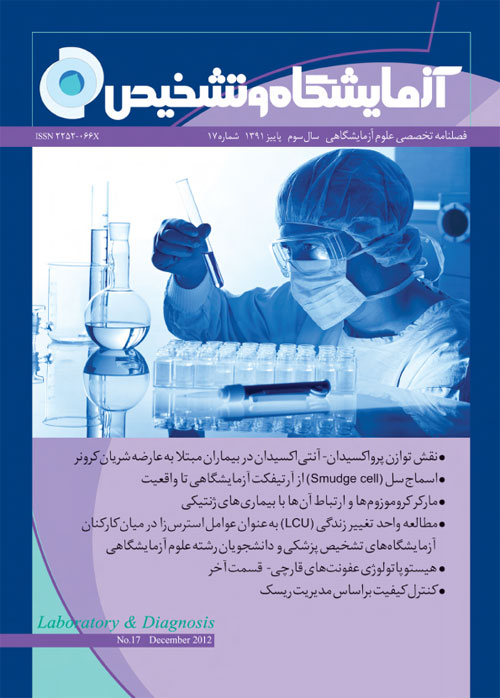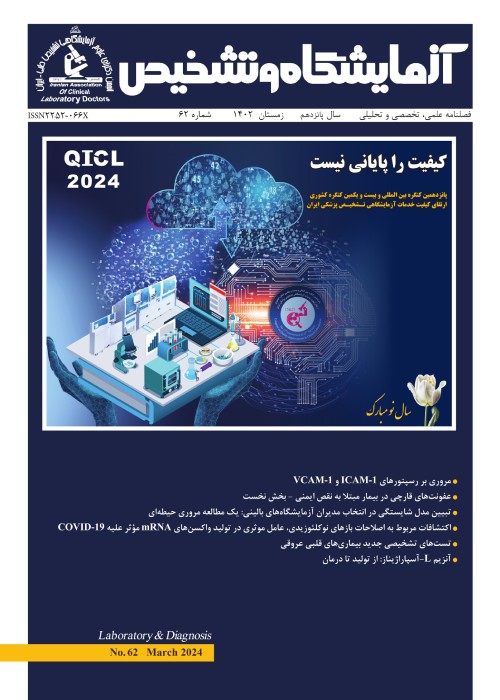فهرست مطالب

فصلنامه آزمایشگاه و تشخیص
پیاپی 17 (پاییز 1391)
- بهای روی جلد: 20,000ريال
- تاریخ انتشار: 1391/09/20
- تعداد عناوین: 15
-
صفحه 25
-
صفحه 38
-
صفحه 51
-
Page 2Background and aim. The balance between ROS generation and antioxidant activity is critical to the pathogenesis of oxidative stress related disorders. In this study the prooxidant – antioxidant balace and its correlation with lipid profile and uric acid was determined, to evaluate the PAB as a prognostic factor for CAD. Materials and Methods Seventy – two patients and sixty eight healthy volunteers were enrolled in this study. The values of PAB was determined by using standard solutions and ELISA method. Triglyceride, total cholesterol, LDL- cholesterol, HDL – cholesterol and uric acid were measured by enzymatic method. Results The PAB values of CAD patients and control group were 70.01±3.36 (HK unit) and 66.40 ± 2.84 (HK unit) respectively. There was no significant difference between PAB values among two groups (P= 0.41). There was no significant difference between uric acid levels among two groups (P= 0.46). There was a significant correlation between the uric acid values among patients and healthy volunteers and PAB values (P <0.01). There was a significant correlation between the TG, chol LDL, HDL HDL values among patients and healthy volunteers and PAB values (P<0.05). Discussion and conclusion This study showed, oxidative stress could be used as a significant risk predictor in the coronary artery disease patients.Keywords: Coronary artery disease, Lipid peroxidation, antioxidants, proosxidants
-
Page 10Chronic Lymphocytic Leukemia is a lymphoproliferative disorder, which its hallmark finding in peripheral blood is lymphocytosis and smudge cells in adult patients. For long time, it was believed that smudge cells are artifacts that form due to cell damage during smear preparation, however it is now believed that smudge cells result from cell apoptosis because of vimentin deficiency and offer a good prognosis. Recently, surface markers such as CD38 and ZAP70 are considered as unfavorable factors in CLL. Moreover some chromosomal studies have opened new attitudes toward CLL prognosis. Among chromosomal abnormality 13q deletion correlate with good prognosis and 11q deletion, 12q trisomy and 17p deletion contribute with unfavorable outcome. Interestingly, increase in number of smudged cells especially more than 30% associate with favorable markers and chromosomal changes in CLL prognosis. Study of smudge cells is a simple, rapid and cost effective test as a predictive factor of CLL invasiveness.
-
Page 13Marker chromosomes are small unbalanced structural chromosomal defects that marked in an ideogram as +mar. The main problem with these markers is their diagnosis prenatally (eg. In amniocentesis). In these situations a clear prognosis of the outcome of the pregnancy is not possible. Although the role of marker chromosomes is not clearly understood. They have been found associated with a number of chromosomal syndromes such as pallister/killian, Cat eye and Prader willi/Angleman syndromes. In the present article, characteristics and structure of marker chromosomes as well as their involvement in different biological phenomenon have been analyzed. Also, the association of marker chromosomes with genetic diseases and their application in construction of artificial chromosomes have been documented.
-
Page 20IntroductionHealthcare employees, particularly clinical laboratories employees are exposed to several stressors which can cause deceased of their job efficiency, job performance, job quality and increased their absenteesm and job turnover. Also, these are many stressors among students can impressed on their health and learning. The aim of this study is to review of LCU as stressors among Iranian employees and students of medical laboratories.Materials and MethodsThis study is a literature review that introduces and identifies the stressors, stress management, life change unit among students and employees of Iranian clinical laboratories by using google scholar, Scopous, Medline, PubMed, Cochran and study of 120 dereferences and selection of 21 references applid in this research. Discussion &ConclusionSeveral researches induced in Iran showed that 30% of hospitals employees patricianly clinical laboratories employees had LCU≥300 which include economic problems and major mortage. However, occupational stressors are the most agents among Iranian nursing employees. Also, intrapersonal stressors are the most agents among medical laboratory students. Establishment of social network, physical activities, spiritualism, pay particular attention to student counseling centers, self-confidence and religious beliefs improvement and time management may increase the students and employees’ satisfaction and performance and decrease stress Lood among these people.Keywords: Life change unit, Stressor, Hospital employees, Clinical laboratories employees, Medical laboratory Sciences Students
-
Page 25Aspergillus colonization of nasal sinuses, bronchiectatic cavities or old tubercular or fungal cavities is relatively common. In the aggressive, invasive form of pulmonary aspergillosis, widespread blood vessel invasion, thrombomycotic vascular occlusions, hemorrhagic and coagulative necrosis are characteristic, and extrapulmonary hematogenous dissemination is not uncommon. Because neutropenia is usually present in aggressive invasive aspergillosis, coagulative necrosis and hemorrhage are the dominant histologic findings. Multiple, nodular infarcts, either pale or hemorrhagic, and laminated, intravascular thrombi are seen in lung. In histologic sections, large numbers of hyphae fill blood vessel lumina, invade vascular walls and extend through necrotic lung parenchyma. The hyphae of Aspergillus have parallel walls, measure 3-6 µm in diameter, are septate, and have dichotomous branching. The morphologic features of these hyphae, however, are not specific for Aspergillus spp., other fungi, particularly Pseudallescheria boydii and Fusarium sll., cannot be definitively distinguished by morphologic characteristics alone. The Zygomycetes have a propensity to invade blood vessels, frequently causing arterial or venous thromboses and subsequent ischemic or hemorrhagic infarction. Invasive pulmonary zygomycosis, which histologically resembles invasive pulmonary aspergillosis, is commonly associated with hematopoietic malignancies, particularly patients with neutropenia. Zygomycete hyphae are easily visualized in H&E and Papanicolaou stains, but often stain weakly by the GMS method. Characteristic hyphae are broad, thin-walled, pleomorphic, irregular branching, 5-20 µm in diameter, and frequently twisted, folded, wrinkled or collapsed. The histopathology of fusariosis is virtually identical to that of rhe aggressive form of invasive aspergillosis. Blood vessel invasion and infarcts with accompanying coagulative necrosis and hemorrhage are common. Hyphae of fusarium spp. In tissue measure 3-8 µm in diameter, have septa, and are similar to aspergillus. A useful, but not pathognomonic clue to the identity of Fusarium spp. Is the presence of constrictions at the site of septa, hyphal varicosities, and terminal or intercalated vesicles. Pseudallescheria boydii also may produce a fungus ball resembling a pulmonary aspergilloma, and invasive pseudallescheriasis mimics invasive aspergillosis, with nosular infarcts secondary to angioinvasion by the fungus and necrotizing pneumonitis with abscesses in non-granulocytopenic hosts. In tissue, the septate hyphae of P. boydii are difficult to distinguish from those of aspergilla, although they are somewhat narrower, measuring 2-5 µm in width, and their pattern of branching is more random. Chromoblastomycosis is characterized by marked hyperkeratosis, parakeratosis and pseudoepitheliomatous hyperplasia that, like cutaneous blastomycosis, paracoccidioidomycosis and coccidioidomycosis, may be misdiagnosed as squamous cell carcinoma. Whitin the dermis, one sses epithelioid and giant cell histiocyte proliferation with foci of neutrophil rich microabscesses. Fungal elements are most commonly found within dermal macrophages and mainly consist of sclerotic bodies or muriform cells 5-12 µm in diameter.
-
Page 38Risk Management is a new Quality Control Program that approved by CMS and CLSI. CLSI Provide 3 documents EP – 18, EP 22 and EP 23 for clinical Laboratories to develop Quality control plans based on Risk Management. This program is a systematic application of management policies, procedures and practices in the tasks of analyzing, evaluating, controlling and monitoring risk. Instrument manufacturers are familiar with risk management principles, as devices must go through extensive risk managements prior to receiving FDA clearance. However clinical Laboratory staff are not usually aware of the manufacturer risk managements, nor are they familiar with the principles of management. The aims of CMS and CLSI are: 1- To introduce risk management principles to the clinical Laboratories. 2- Encourage partnership between the manufacturer and Laboratory using the testing devices. 3- Provide a process for Laboratories to develop quality control plans based on risk management principles.


